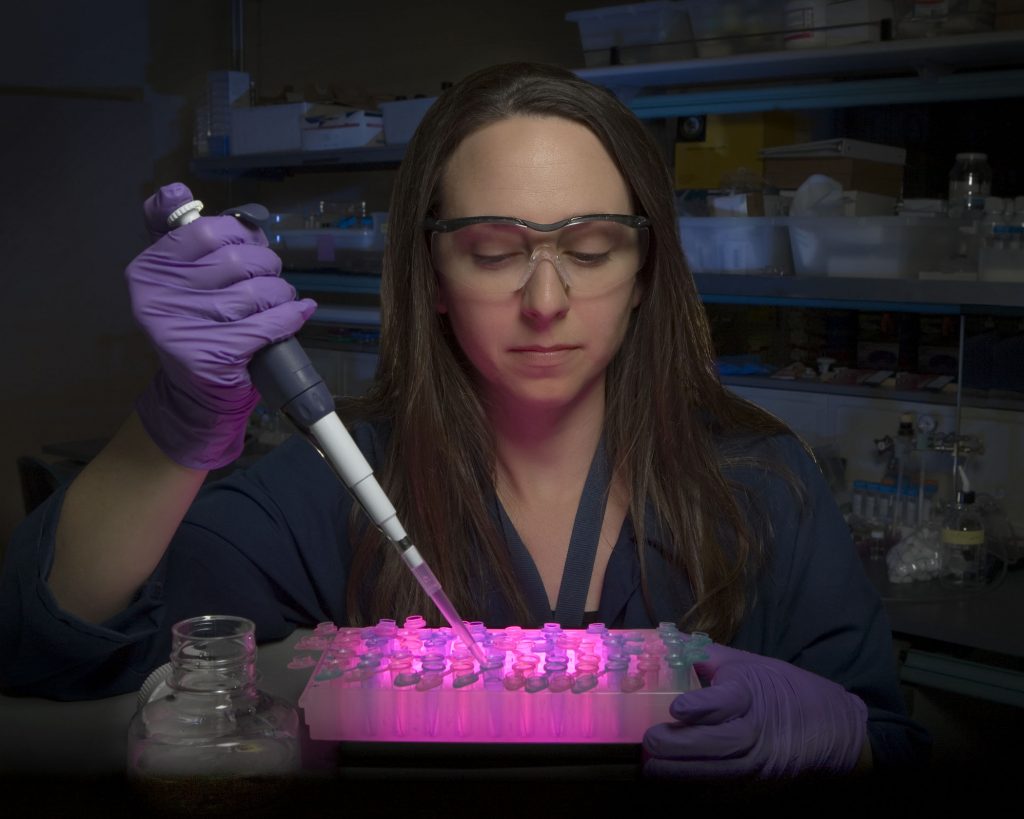
ALBUQUERQUE, N.M. — Who would have guessed that when the Star Trek medical diagnostic tool known as the tricorder makes its appearance in real life, the first user might be . . . your dentist.
According to a paper in the March 27 issue of PNAS (the Proceedings of the National Academy of Sciences), a recently completed pilot study conducted with the University of Michigan shows that a Sandia National Laboratories handheld device determined in minutes — from a tiny sample of saliva alone — not only if a patient has gum disease but quantitatively how advanced the disease is.
“The gold standard for any medical test is when instruments are used to examine human patients,” says Sandia researcher Amy Herr. “The pilot study allowed us to compare our results to accepted clinical measurements. Then we could statistically validate both the periodontal disease biomarker and the new microfluidic instrument.
“We achieved faster and more reproducible results because we combined steps that ordinarily require time-consuming manual handling by many people, into a single automated device.”
Sandia is a National Nuclear Security Administration (NNSA) laboratory.
Because the amount of sample fluid needed for testing is so small, Herr sees further applications in other disease areas — including potentially improved diagnosis of prostate and breast cancer — as well as rapid measurements of serum in animal models employed in vaccine development research.
Says Sandia researcher Anup Singh, “This technology also has great promise for Sandia’s efforts in homeland defense. We have on-going efforts to use the diagnostic platform to detect biotoxins and other markers in bodily fluids to be able to diagnose exposure to a biological agent.”
“We’ve filed patents and technical advances to protect the work,” Herr says. “The study has sparked commercial and university interest in our inventions. Our team — an interdisciplinary group of internal and external collaborators — believes Sandia’s contributions in this area could advance personalized medicine. So we’re motivated to extend the limits of Sandia’s lab-on-a-chip tools.”
A “lab on a chip” refers to an entire laboratory on an area the size of a computer chip, requiring only minute amounts of material to perform automated chemical analysis.
How it works
While components of the saliva-detection technique were reported earlier by Sandia, this is the first comprehensive study of Sandia’s integrated clinical method.
The basic principle? “Biomedical researchers have suspected that changes in the amount or type of proteins present may be useful as biological markers in disease diagnosis,” says Herr. “Our current work with a particular enzyme in saliva supports that hypothesis regarding periodontal disease.”
Aiding dental practitioners, the pocket-sized device measures the state of biomarkers to determine how much the disease has been set back. Its progress may be cloaked, silently advancing or retreating without showing any signs.
“Periodontitis can be episodic in nature,” says Herr. “You need to know the stage of disease progression to diagnose and treat the illness most effectively. The enzyme [biomarker] that we monitored decreased or stabilized if the treatment was working well.”
Often, owing to the time and expense involved, practitioners formerly had not been able to perform extensive biochemical investigations.
The work, funded by the National Institute of Dental and Craniofacial Research (NIDCR) — one of 20 institutes in the National Institutes of Health — is the first application using microliters of saliva, a painlessly and easily secured fluid. The real-life alternative for the most part has been quasi-subjective physiological measurements, such as gum recession and gum bleeding on probing, to diagnose periodontitis.
Unlike Sandia’s MicroChemLab — its patented version of a lab on a chip — which reports multiple protein signatures in fluids of interest, the clinical diagnostic instrument described in PNAS is a lab on a chip designed to quantify the amount of a specific protein (or panel of proteins) present in particular biological fluids. Monitoring quantities of specific proteins makes the tool useful as a clinical diagnostic.
Using a disposable lab-on-a-chip cartridge, the device makes use of a molecular sieve made out of a polyacrylamide gel. The location of the sieve in the microfluidic chips is determined using photo-lithographical methods adapted from the semiconductor industry. The gel is porous, with very small openings. A low electrical current (measured in micro-amps) is passed through the gel and a process called electrophoresis moves charged proteins through it. The gel has a gelatin-like consistency and, by permitting the easy passage of smaller molecules and slowing the passage of larger ones, quickly separates proteins contained in the saliva. Prior to this separation, the proteins are brought into contact with specific antibodies chosen on their ability to bind to the biomarkers. The antibodies are pre-labeled with fluorescent molecules attached to them. Interrogation by laser of these combined molecules — fluorescent antibody and fluorescent antibody bound to the biomarker — determines the amount of biomarker present, indicating the degree of periodontitis.
Sandia authors of the study, in addition to Herr and Singh, the NIDCR project primary investigator, include Anson Hatch, Daniel Throckmorton, James Brennan, and Huu Tran, as well as Will Giannobile of the School of Dentistry at the University of Michigan, Ann Arbor.
More information can be obtained at: www.sandia.gov/mission/homeland/chembio/development/biotechnology/nih2.html
